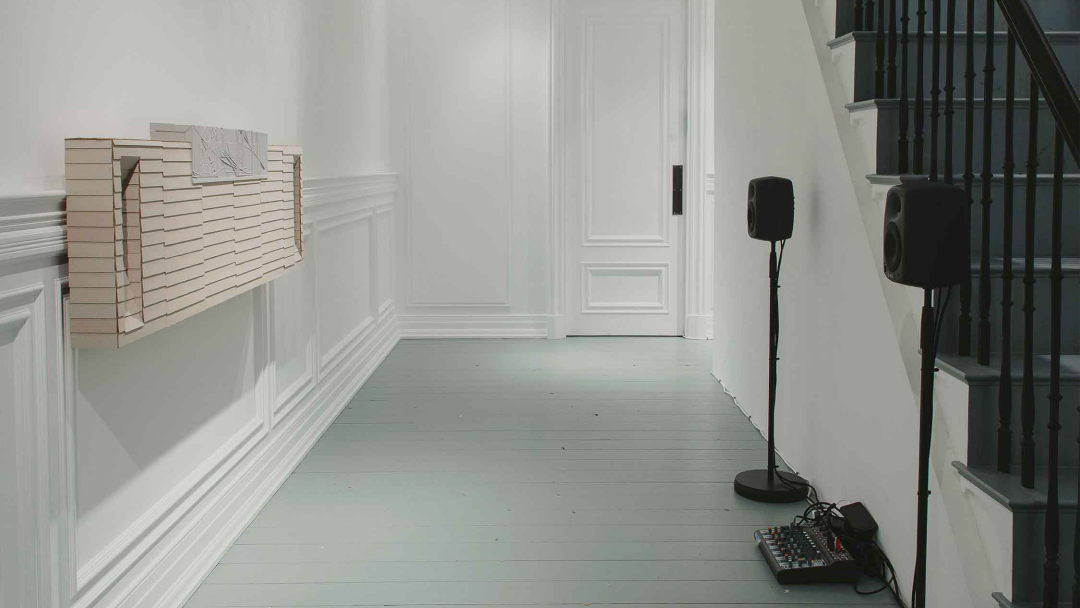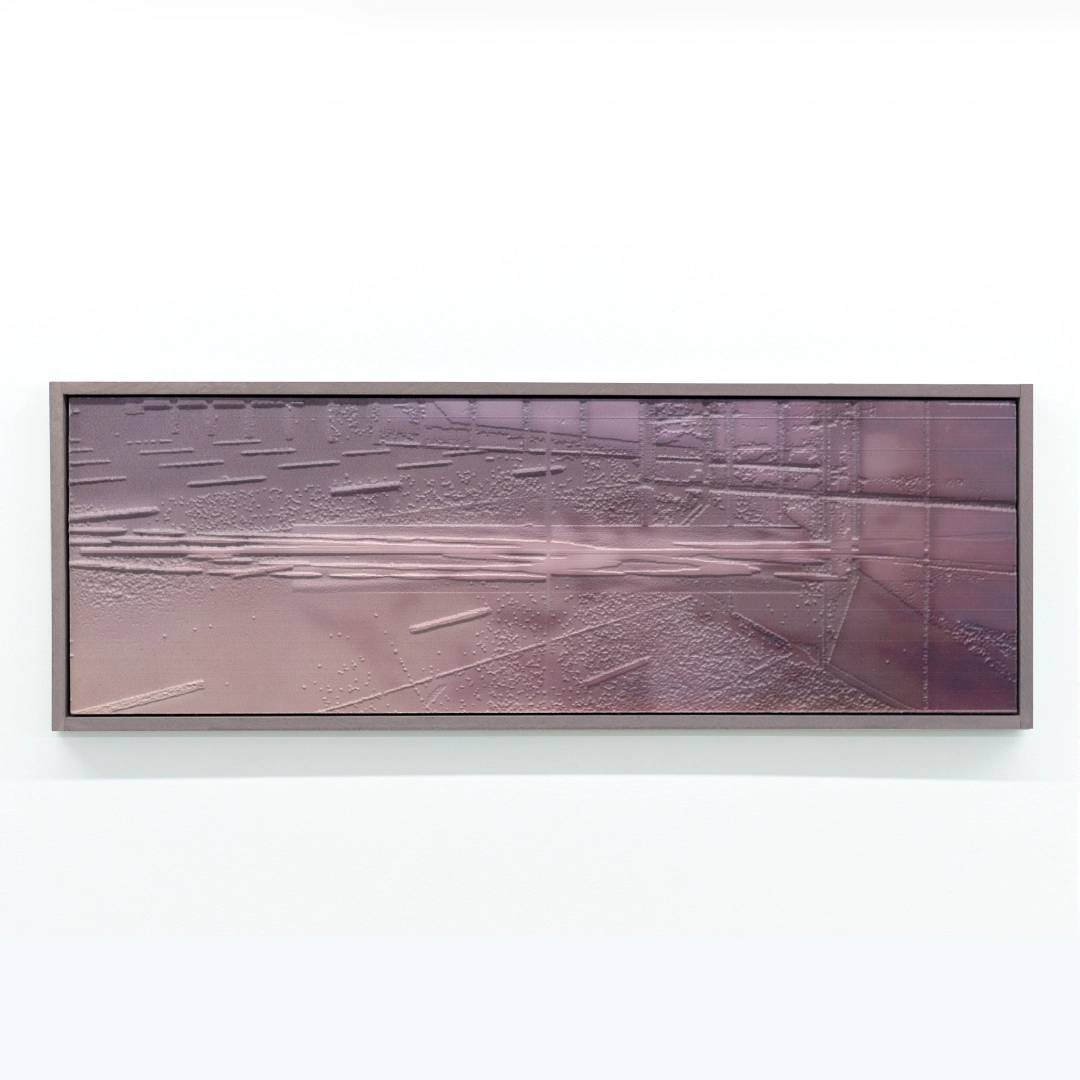Rhythms and patterns of architectural compositions arouse a deep fascination in Lucas Dupuy. With his extensive collection of books on Brutalism and admiration for close observation, the London-based visual artist moves smoothly between painting, relief, collaging, publishing, drawing and sound. Yet contrasts can be seen between the angular and the soft.
‘I’ve always been interested in how light affects everything. A cloud can come and take the light away in ten minutes; that fleeting moment is quite interesting. I remember I went to Blue Planet Sky by James Turrell in a museum in Kanazawa, Japan. I sat in the room for an hour and a half, just observing the light move in and out of the space, which was very calming and fascinating.’ Sharp perceptions of ephemeral moments and the versatility of patterns and shapes are nothing strange to London-based visual artist Lucas Dupuy. On the contrary, the artist applies his ability to look closer and deeper through his entire artistic practice.


.webp)
On the first sunny Friday of 2025 in Amsterdam, we e-meet with Lucas in his artist studio through a video call. He is in between preparations for planned shows in New York and Munich. Working on multiple projects simultaneously, Lucas moves fluidly between media in his multifaceted practice, which spans paintings, collages, reliefs, drawings, publishing and sound. For an hour, we discuss his abstract visual language and artistic approach. From the architectural movement of Brutalism to balancing tension and calm through layered materials, colour selection, the link between science and nature and the soothing effect of patterns and rhythms within visual and verbal systems of chaos.


‘It was a jumping point that led me to research different kinds of plans and models'
Lucas’ early exploration of systems and structures stems from his experiences with dyslexia. ‘As a child and teenager, I always focused on the language side of things. I struggled to read and the words would just jumble on the page. It felt very overwhelming.’ When he discovered the genre of ‘concrete poetry’ at university – a crossover between visual arts and poetry – he realised that a certain grammar isn’t solely conveyed through words, but can also hide in the rhythm or fixed repetition of images. ‘It was a jumping point that led me to research different kinds of plans and models, such as layouts, design and ultimately, architecture.’ In his abstract and monochrome collages, Lucas plays with geometric blocks and shapes, rugged patterns and layering. ‘The way that I build up these collages is by running them through the Xerox machine [a photocopier] over and over again, which brings up an element of chance in the process. I always find it quite exciting to just send ten images to print and not really look at them, keep sending them, putting the paper in over and over again.’

The architectural forms in his collages possess a poetic quality, particularly inspired by the style of Brutalism. This modernist movement flourished between the 1950s and 1970s, emphasising minimal constructions and bare building materials - such as exposed concrete - to create imposing, robust structures. A defining figure of the movement was the Swiss architect Le Corbusier, who sought a geometric utopia, stating that ‘a house is a machine for living in’. He intended to design pure, functional buildings based on a machine-age aesthetic: flat roofs, concrete pillars, and horizontal windows. Although this vision was quite revolutionary at the time, his designs often lacked a social dimension, making them alienating to live in. Yet, through these modernist designs, Le Corbusier developed an architectural language that allowed natural light and air to flow freely into the interior spaces. He fostered an atmosphere that could be experienced as calming and in harmony with nature.
An interplay of natural light and indoor space is also present in the work of Japanese architect Tadao Ando, one of Lucas’s favourites, who is known for his minimalist and geometric aesthetic. ‘He focuses a lot on how light enters a building, for example in his work called the Church of the Light. His design revolves around the sun shining directly into the church through the cross-shaped window; the light moves around the building in very interesting ways, creating all sorts of beautiful lines.’
The architectural forms in his collages possess a poetic quality, particularly inspired by the style of Brutalism. This modernist movement flourished between the 1950s and 1970s, emphasising minimal constructions and bare building materials - such as exposed concrete - to create imposing, robust structures. A defining figure of the movement was the Swiss architect Le Corbusier, who sought a geometric utopia, stating that ‘a house is a machine for living in’. He intended to design pure, functional buildings based on a machine-age aesthetic: flat roofs, concrete pillars, and horizontal windows. Although this vision was quite revolutionary at the time, his designs often lacked a social dimension, making them alienating to live in. Yet, through these modernist designs, Le Corbusier developed an architectural language that allowed natural light and air to flow freely into the interior spaces. He fostered an atmosphere that could be experienced as calming and in harmony with nature.
An interplay of natural light and indoor space is also present in the work of Japanese architect Tadao Ando, one of Lucas’s favourites, who is known for his minimalist and geometric aesthetic. ‘He focuses a lot on how light enters a building, for example in his work called the Church of the Light. His design revolves around the sun shining directly into the church through the cross-shaped window; the light moves around the building in very interesting ways, creating all sorts of beautiful lines.’


Light can transform the mood of a space in an instant. Lucas’ practice reflects a sensitivity to similar subtleties in perception, mainly through his method of searching for the brutal, the blurred and the soft. Especially in his paintings, he strives to evoke a sense of stability and calm, as an outlet for his anxiety. In contrast to his rigid and Brutalist collages or reliefs, these paintings are soft and serene with blurred edges and fluid colours, almost organic. ‘I’m very conscious about my use of colour, and it can become quite a stressful part of the making process. My colour palette is reasonably muted and calming. I don’t want the paint to be overbearing in a way that it feels uncomfortable.’ Lucas applies acrylic paint or gouache to raw materials, such as hessian or raw canvas, and builds up many layers in an intuitive way, ultimately resulting in elongated brushstrokes appearing on the canvas.

‘It's like collaging things together in just a very different way'
These blurred lines on his paintings effectively evoke the presence of neural networks, branches or strands of DNA. ‘I've been researching fractals – infinite, self-repeating geometric shapes – and the thin line between science and nature, through a book called Chaos and Fractals: New Frontiers of Science. Lots of images in that book are made by early computer programs that use science to expose structures of natural phenomena. There’s always a mathematical process to them.’ With their layered textures, soft – almost pastel-like – colours and suggestion of dynamic movement, Lucas’ paintings echo this scientific principle, capturing the ephemeral patterns and fleeting moments of nature. A sun kissing the horizon, a seashore, a forest: concrete examples that Lucas reduces to their minuscule essence, both reassuring and befuddling us about the eternity of infinite patterns and rhythms of earth and universe
In recent years, Lucas has expanded his practice to sound compositions and music-making, drawing on field recordings he made during trips to Japan and using tools like granular synthesis. His methods of layering and collaging are quite similar yet so distinctive. ‘It's like collaging things together in just a very different way. I used a lot of sounds from crickets, rain, cracking ice, or beeping sounds at train stations. A lot of times these samples are abstracted so much throughout the making process that you can’t tell what they are.’ Lucas even compares working with granular synthesis in Ableton to the process of painting, in both cases abstracting the observable material, either sound or paint, into something unrecognisable, atmospheric or soothing, allowing the spectator to breathe and enter a state of sensory awareness for the complexity of organic systems.





‘I build up certain bits of paint in certain areas. Then, I paint over them again and repeat the process. In a way, it does feel like a form of masking, as if there’s another layer beneath the surface.’ Lucas seems to put just enough, yet not all, of his cards on the table. His paintings speak a visual language all of their own, with untold stories on the horizon…





.webp)

